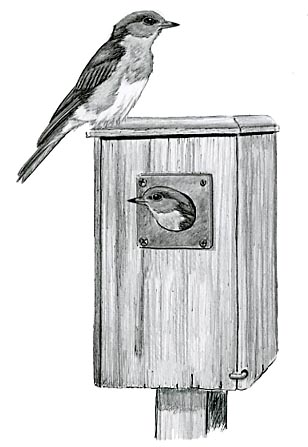
Dear Bird Folks,
A month ago we bought a birdhouse with a side that opens so we can see the nest and hopefully, the baby birds. A week later a pair of bluebirds moved in, built a nest, and perhaps have laid some eggs. I say “perhaps” because my husband won’t let me look in the box. He’s afraid that if I disturb them the birds may abandon the nest and not return, even though the instructions that came with the box say it’s okay to peek in. Who I should listen to, my husband or the birdhouse company?
– Brooke, Paxton, MA
Your husband is very wise, Brooke,
As an official member of the Husbands Union, I’m obligated to say that, no matter what. But really, it’s always a good idea to be skeptical about claims made by manufacturers. They’ll say anything to sell their products. One time I bought a series of tapes that were suppose to teach me French while I slept. After six weeks of sleep-listening, I never learned a single word of French. Oddly, I did find myself putting snails on my cereal each morning. Because of that I traded the French tapes for tapes on speaking Danish. I don’t really care about learning Danish, but it was much nicer craving HŠagen-Dazs each morning instead of snails.
The natural world is filled with many myths. Three of the most common myths are: ostriches hide their heads in the sand, picking up toads will give you warts, and pug dogs are really cute. That last one really surprises me. Another common myth is that if you touch a bird’s nest the mother bird will smell you and abandon the nest. This myth was probably started by well-meaning parents who wanted to keep their kids away from nesting birds. The truth is, most songbirds have a poorly developed sense of smell. They wouldn’t be able smell you no matter how stinky you are.
I think worrying about disturbing a nesting bird is a reasonable concern. But birds that nest in our backyards have grown accustomed to humans and our intruding ways. We are always digging in the shrubs while gardening or looking for lost tennis balls. The adult bird typically flies off its hidden nest and waits for the oblivious human to move away before it sneaks back to continue incubating its eggs.
Of course, like people, there are a few psycho birds that will take the more aggressive approach. If you get too close to a mockingbird’s nest, for example, you would quickly forget all about looking for that tennis ball and immediately start dialing 911.
Fortunately, bluebirds have no such aggression toward people. They not only have become very tolerant of us, but they have learned to take advantage of what we have to offer them. In the winter, they survive by eating the berries on our holly trees and other plantings. They come in flocks to heated birdbaths or pick at our suet feeders. In the spring, they have learned to use manmade nest boxes to replace natural tree cavities, which have become harder to find due in part to our obsession with cutting down dead trees. It is these nest boxes that have helped stop the decades of declining bluebird population, making them a common sight in many areas once again.
However, merely putting out nest boxes isn’t totally what has helped bring the bluebirds back. It is putting out nest boxes and monitoring them. Dedicated people have spent hours making notes on what has happened both outside and, yes, inside of the boxes. Bluebird nest monitors regularly open and check up on what is going on inside the box…and the bluebirds don’t care a bit. As amazing as it seems, some nest monitors report opening the box, to count the eggs, only to find the mother bluebird still sitting tight, refusing to budge. In such a case the monitor would simply reach in the box, lift up the stubborn mother, count the eggs and put her back on the nest, without hearing so much as a chirp of protest.
There is nothing wrong with taking the occasional peek inside your new birdhouse. It’s fun to witness how quickly the tiny birds grow. It only takes a few short weeks. When I inspect my boxes I always pick a warm, sunny day so the eggs or baby birds don’t get chilled. I usually tap on the box once or twice, giving the mother a chance to take off before she has to see my giant face staring in at her. When I finally do open the box, I stand to one side just in case the mother is still inside and decides to bolt. Having a bluebird fly up your nose isn’t as much fun as it sounds. Finally, once you’ve noticed that the babies are getting big and crowding the box it’s time to stop looking. You don’t want any babies jumping out before they can fly. That’s a stress you can do without.
You and the birdhouse company are right, Brooke. Looking into nest boxes is fine. Let your husband know that I’m sorry, but I can’t back him up this time. To make it up to him, mention that the next time he’s on Cape Cod I’ll buy him a big bowl of HŠagen-Dazs. Does he like his ice cream with or without snails?